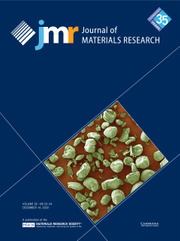Crossref Citations
This article has been cited by the following publications. This list is generated based on data provided by
Crossref.
Dzionk, C
Metzner, H
Hessler, S
and
Mahnke, H.-E
1997.
Phase formation during the reactive annealing of Cu–In films in H2S atmosphere.
Thin Solid Films,
Vol. 299,
Issue. 1-2,
p.
38.
Grzanna, J.
and
Migge, H.
1997.
Chemical stability of CuInS2 in oxygen at 298 K.
Journal of Materials Research,
Vol. 12,
Issue. 2,
p.
355.
Makhova, L.
Szargan, R.
and
Konovalov, I.
2005.
Investigation of the growth process and properties of CuIn5S8 and AgIn5S8 spinel thin films.
Thin Solid Films,
Vol. 472,
Issue. 1-2,
p.
157.
Tomashik, Vasyl
2006.
Cu-In-S Ternary Phase Diagram Evaluation.
MSI Eureka,
Vol. 36,
Issue. ,
p.
10.11955.1.7.
2006.
Non-Ferrous Metal Systems. Part 1.
Vol. 11C1,
Issue. ,
p.
1.
Rodriguez-Alvarez, H.
Kötschau, I.M.
and
Schock, H.W.
2008.
Pressure-dependent real-time investigations on the rapid thermal sulfurization of Cu–In thin films.
Journal of Crystal Growth,
Vol. 310,
Issue. 15,
p.
3638.
Nishiwaki, Shiro
and
Shafarman, William N.
2008.
Composition control of Cu(InGa)(SeS)2 deposited by elemental coevaporation.
Journal of Applied Physics,
Vol. 104,
Issue. 3,
Painchaud, Thomas
Barreau, Nicolas
and
Kessler, John
2009.
Solar Grade CuInS2 Thin Films Grown at 250°C.
MRS Proceedings,
Vol. 1165,
Issue. ,
Barreau, Nicolas
and
Tessier, Mickael
2009.
Characterization of Indium Sulfide Thin Films Containing Copper.
MRS Proceedings,
Vol. 1165,
Issue. ,
Scragg, Jonathan J.
Dale, Phillip J.
Colombara, Diego
and
Peter, Laurence M.
2012.
Thermodynamic Aspects of the Synthesis of Thin‐Film Materials for Solar Cells.
ChemPhysChem,
Vol. 13,
Issue. 12,
p.
3035.
Chen, Bingkun
Chang, Shuai
Li, Deyao
Chen, Liangliang
Wang, Yongtian
Chen, Tao
Zou, Bingsuo
Zhong, Haizheng
and
Rogach, Andrey L.
2015.
Template Synthesis of CuInS2 Nanocrystals from In2S3 Nanoplates and Their Application as Counter Electrodes in Dye-Sensitized Solar Cells.
Chemistry of Materials,
Vol. 27,
Issue. 17,
p.
5949.
Huang, Tang Jiao
Yin, Xuesong
Tang, Chunhua
Qi, Guojun
and
Gong, Hao
2016.
Influence of Ligands on the Formation of Kesterite Thin Films for Solar Cells: A Comparative Study.
ChemSusChem,
Vol. 9,
Issue. 9,
p.
1032.
Yue, Wenjin
Wei, Feiyu
He, Chenbin
Wu, Dandan
Tang, Nengwen
and
Qiao, Qiquan
2017.
l-Cysteine assisted-synthesis of 3D In2S3 for 3D CuInS2 and its application in hybrid solar cells.
RSC Advances,
Vol. 7,
Issue. 60,
p.
37578.
Coughlan, Claudia
Ibáñez, Maria
Dobrozhan, Oleksandr
Singh, Ajay
Cabot, Andreu
and
Ryan, Kevin M.
2017.
Compound Copper Chalcogenide Nanocrystals.
Chemical Reviews,
Vol. 117,
Issue. 9,
p.
5865.
Le Tulzo, Harold
Schneider, Nathanaelle
Lincot, Daniel
and
Donsanti, Frédérique
2019.
Toward an all-Atomic Layer Deposition (ALD) process for Cu(In,Ga)(S,Se)2 (CIGS)-type solar cell.
Solar Energy Materials and Solar Cells,
Vol. 200,
Issue. ,
p.
109965.
Li, Xian
Tu, Datao
Yu, Shaohua
Song, Xiaorong
Lian, Wei
Wei, Jiaojiao
Shang, Xiaoying
Li, Renfu
and
Chen, Xueyuan
2019.
Highly efficient luminescent I-III-VI semiconductor nanoprobes based on template-synthesized CuInS2 nanocrystals.
Nano Research,
Vol. 12,
Issue. 8,
p.
1804.
Dehghani, Mehdi
Parvazian, Ershad
Tehrani, Nastaran Alamgir
Taghavinia, Nima
and
Samadpour, Mahmoud
2021.
A novel low-temperature growth of uniform CuInS2 thin films and their application in selenization/sulfurization-free CuInS2 solar cells.
Materials Today Communications,
Vol. 26,
Issue. ,
p.
102050.
Shi, Chuang
Li, Na
and
Zhang, Weibin
2021.
Thermodynamic assessment of the Sb–S and In–S binary systems.
International Journal of Materials Research,
Vol. 112,
Issue. 5,
p.
373.
Sopiha, Kostiantyn V.
Larsen, Jes K.
Keller, Jan
Edoff, Marika
Platzer-Björkman, Charlotte
and
Scragg, Jonathan J. S.
2022.
Off-stoichiometry in I–III–VI2 chalcopyrite absorbers: a comparative analysis of structures and stabilities.
Faraday Discussions,
Vol. 239,
Issue. ,
p.
357.
Bora, Ankita
Prudnikau, Anatol
Fu, Ningyuan
Hübner, René
Borchert, Konstantin B. L.
Schwarz, Dana
Gaponik, Nikolai
and
Lesnyak, Vladimir
2022.
Seed-Mediated Synthesis of Photoluminescent Cu–Zn–In–S Nanoplatelets.
Chemistry of Materials,
Vol. 34,
Issue. 20,
p.
9251.

